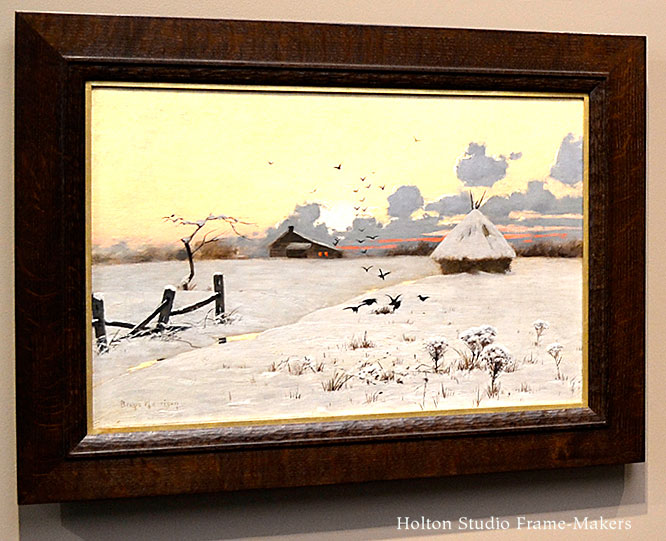Birge Harrison (1854-1929) was born in Pennsylvania and was active in the northeast at the turn of the last century. Years ago I stumbled on his 1909 book, Landscape Painting, so was excited to get an inquiry a couple of years ago from the Figge Art Museum about re-framing a Harrison in their collection. Working with their Manager of Collections and Exhibitions, Andrew Wallace, and based on the image he emailed to me, we settled on a No. 17.4 CV—3″ frame with a gilt liner. Mr Wallace kindly sent me this picture of it on the wall of the museum, and included the remark, “Everyone comments on it — it is as if they have never seen the painting before, though it has been in the collection since 1929.”
It’s hard to overstate what a compliment this is. The entire purpose of the frame is to help the viewer see the picture fully and truly; and the greatest failure of most frames isn’t the quality of the workmanship or material (important as those are), or the quantity of ornament, but the arbitrariness of the ornament and design generally in relation to the picture, and the seeming carelessness and indifference the frame choice reflects about what the artist cared most about: that we see the thing he’s painted. Consequently, bad frames distract the eye and ignore and even contradict the characteristics of the painting. They often attempt to flatter the picture in an abstract manner, that is, as a WORK OF ART, an object of value. But they are rarely based on the artistic characteristics of the picture. A good frame, however, complements, enhances, articulates and amplifies the painted scene. Not only do I feel we succeeded, but what I appreciate about Mr Wallace’s remark is that it conveys the public’s appreciation of our success—even if they don’t cite the frame’s role. In fact, the frame should do its work without drawing attention to itself, and demonstrates its success by not drawing attention to itself but to the picture.
I didn’t see the old frame, but it may have been original to it or of the era. No matter. If it wasn’t helpful to the painting, it doesn’t belong on it.
More on Birge Harrison…
